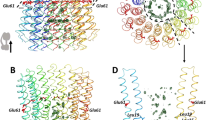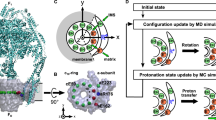Abstract
The microscopic mechanism of coupled c-ring rotation and ion translocation in F1Fo-ATP synthases is unknown. Here we present conclusive evidence supporting the notion that the ability of c-rings to rotate within the Fo complex derives from the interplay between the ion-binding sites and their nonhomogenous microenvironment. This evidence rests on three atomic structures of the c15 rotor from crystals grown at low pH, soaked at high pH and, after N,N′-dicyclohexylcarbodiimide (DCCD) modification, resolved at 1.8, 3.0 and 2.2 Å, respectively. Alongside a quantitative DCCD-labeling assay and free-energy molecular dynamics calculations, these data demonstrate how the thermodynamic stability of the so-called proton-locked state is maximized by the lipid membrane. By contrast, a hydrophilic environment at the a-subunit–c-ring interface appears to unlock the binding-site conformation and promotes proton exchange with the surrounding solution. Rotation thus occurs as c-subunits stochastically alternate between these environments, directionally biased by the electrochemical transmembrane gradient.
This is a preview of subscription content, access via your institution
Access options
Subscribe to this journal
Receive 12 print issues and online access
$259.00 per year
only $21.58 per issue
Buy this article
- Purchase on Springer Link
- Instant access to full article PDF
Prices may be subject to local taxes which are calculated during checkout






Similar content being viewed by others
References
Mitchell, P. Coupling of phosphorylation to electron and hydrogen transfer by a chemi-osmotic type of mechanism. Nature 191, 144–148 (1961).
Dimroth, P. Primary sodium ion translocating enzymes. Biochim. Biophys. Acta 1318, 11–51 (1997).
Noji, H., Yasuda, R., Yoshida, M. & Kinosita, K., Jr. Direct observation of the rotation of F1-ATPase. Nature 386, 299–302 (1997).
Abrahams, J.P., Leslie, A.G.W., Lutter, R. & Walker, J.E. Structure at 2.8 Å resolution of F1-ATPase from bovine heart mitochondria. Nature 370, 621–628 (1994).
Boyer, P.D. The binding change mechanism for ATP synthase—some probabilities and possibilities. Biochim. Biophys. Acta 1140, 215–250 (1993).
Forgac, M. Vacuolar ATPases: rotary proton pumps in physiology and pathophysiology. Nat. Rev. Mol. Cell Biol. 8, 917–929 (2007).
Stock, D., Leslie, A.G.W. & Walker, J.E. Molecular architecture of the rotary motor in ATP synthase. Science 286, 1700–1705 (1999).
Pogoryelov, D. et al. The c15 ring of the Spirulina platensis F-ATP synthase: F1/F0 symmetry mismatch is not obligatory. EMBO Rep. 6, 1040–1044 (2005).
Meier, T., Polzer, P., Diederichs, K., Welte, W. & Dimroth, P. Structure of the rotor ring of F-Type Na+-ATPase from Ilyobacter tartaricus. Science 308, 659–662 (2005).
Meier, T. et al. Complete ion-coordination structure in the rotor ring of Na+-dependent F-ATP synthases. J. Mol. Biol. 391, 498–507 (2009).
Murata, T., Yamato, I., Kakinuma, Y., Leslie, A.G. & Walker, J.E. Structure of the rotor of the V-Type Na+-ATPase from Enterococcus hirae. Science 308, 654–659 (2005).
Pogoryelov, D., Yildiz, Ö., Faraldo-Gómez, J.D. & Meier, T. High-resolution structure of the rotor ring of a proton-dependent ATP synthase. Nat. Struct. Mol. Biol. 16, 1068–1073 (2009).
Preiss, L., Yildiz, Ö., Hicks, D.B., Krulwich, T.A. & Meier, T. A new type of proton coordination in an F1Fo-ATP synthase rotor ring. PLoS Biol. 8, e1000443 (2010).
Vik, S.B. & Antonio, B.J. A mechanism of proton translocation by F1F0 ATP synthases suggested by double mutants of the a subunit. J. Biol. Chem. 269, 30364–30369 (1994).
Junge, W., Lill, H. & Engelbrecht, S. ATP synthase: an electrochemical transducer with rotatory mechanics. Trends Biochem. Sci. 22, 420–423 (1997).
Steed, P.R. & Fillingame, R.H. Aqueous accessibility to the transmembrane regions of subunit c of the Escherichia coli F1F0 ATP synthase. J. Biol. Chem. 284, 23243–23250 (2009).
Lau, W.C. & Rubinstein, J.L. Structure of intact Thermus thermophilus V-ATPase by cryo-EM reveals organization of the membrane-bound VO motor. Proc. Natl. Acad. Sci. USA 107, 1367–1372 (2010).
Krah, A., Pogoryelov, D., Meier, T. & Faraldo-Gómez, J.D. On the structure of the proton-binding site in the Fo rotor of chloroplast ATP synthases. J. Mol. Biol. 395, 20–27 (2010).
Krah, A. et al. Structural and energetic basis for H+ versus Na+ binding selectivity in ATP synthase Fo rotors. Biochim. Biophys. Acta 1797, 763–772 (2010).
Kluge, C. & Dimroth, P. Kinetics of inactivation of the F1Fo ATPase of Propionigenium modestum by dicyclohexylcarbodiimide in relationship to H+ and Na+ concentration: probing the binding site for the coupling ions. Biochemistry 32, 10378–10386 (1993).
Lightowlers, R.N., Howitt, S.M., Hatch, L., Gibson, F. & Cox, G.B. The proton pore in the Escherichia coli F0F1-ATPase: a requirement for arginine at position 210 of the a-subunit. Biochim. Biophys. Acta 894, 399–406 (1987).
Erez, E., Fass, D. & Bibi, E. How intramembrane proteases bury hydrolytic reactions in the membrane. Nature 459, 371–378 (2009).
Krepkiy, D. et al. Structure and hydration of membranes embedded with voltage-sensing domains. Nature 462, 473–479 (2009).
Krishnamurthy, H., Piscitelli, C.L. & Gouaux, E. Unlocking the molecular secrets of sodium-coupled transporters. Nature 459, 347–355 (2009).
Neale, E.J., Rong, H., Cockcroft, C.J. & Sivaprasadarao, A. Mapping the membrane-aqueous border for the voltage-sensing domain of a potassium channel. J. Biol. Chem. 282, 37597–37604 (2007).
Rosenbaum, D.M., Rasmussen, S.G. & Kobilka, B.K. The structure and function of G-protein-coupled receptors. Nature 459, 356–363 (2009).
Sitkoff, D., Sharp, K.A. & Honig, B. Correlating solvation free energies and surface tensions of hydrocarbon solutes. Biophys. Chem. 51, 397–403, discussion 404–409 (1994).
Gonen, T. et al. Lipid-protein interactions in double-layered two-dimensional AQP0 crystals. Nature 438, 633–638 (2005).
Long, S.B., Tao, X., Campbell, E.B. & MacKinnon, R. Atomic structure of a voltage-dependent K+ channel in a lipid membrane-like environment. Nature 450, 376–382 (2007).
Pogoryelov, D. et al. Probing the rotor subunit interface of the ATP synthase from Ilyobacter tartaricus. FEBS J. 275, 4850–4862 (2008).
Gibbons, C., Montgomery, M.G., Leslie, A.G. & Walker, J.E. The structure of the central stalk in bovine F1-ATPase at 2.4 Å resolution. Nat. Struct. Biol. 7, 1055–1061 (2000).
Meier, T., Matthey, U., Henzen, F., Dimroth, P. & Müller, D.J. The central plug in the reconstituted undecameric c cylinder of a bacterial ATP synthase consists of phospholipids. FEBS Lett. 505, 353–356 (2001).
Pogoryelov, D. et al. Sodium dependency of the photosynthetic electron transport in the alkaliphilic cyanobacterium Arthrospira platensis. J. Bioenerg. Biomembr. 35, 427–437 (2003).
Sebald, W., Machleidt, W. & Wachter, E.N. N′-dicyclohexylcarbodiimide binds specifically to a single glutamyl residue of the proteolipid subunit of the mitochondrial adenosinetriphosphatases from Neurospora crassa and Saccharomyces cerevisiae. Proc. Natl. Acad. Sci. USA 77, 785–789 (1980).
Kluge, C. & Dimroth, P. Specific protection by Na+ or Li+ of the F1F0-ATPase of Propionigenium modestum from the reaction with dicyclohexylcarbodiimide. J. Biol. Chem. 268, 14557–14560 (1993).
Meier, T. et al. Evidence for structural integrity in the undecameric c-rings isolated from sodium ATP synthases. J. Mol. Biol. 325, 389–397 (2003).
Valiyaveetil, F., Hermolin, J. & Fillingame, R.H. pH dependent inactivation of solubilized F1F0 ATP synthase by dicyclohexylcarbodiimide: pKa of detergent unmasked aspartyl-61 in Escherichia coli subunit c. Biochim. Biophys. Acta 1553, 296–301 (2002).
Viard, M., Gallay, J., Vincent, M. & Paternostre, M. Origin of laurdan sensitivity to the vesicle-to-micelle transition of phospholipid-octylglucoside system: a time-resolved fluorescence study. Biophys. J. 80, 347–359 (2001).
Bond, P.J. & Sansom, M.S. Membrane protein dynamics versus environment: simulations of OmpA in a micelle and in a bilayer. J. Mol. Biol. 329, 1035–1053 (2003).
Bond, P.J., Faraldo-Gòmez, J.D., Deol, S.S. & Sansom, M.S. Membrane protein dynamics and detergent interactions within a crystal: a simulation study of OmpA. Proc. Natl. Acad. Sci. USA 103, 9518–9523 (2006).
von Ballmoos, C. & Dimroth, P. Two distinct proton binding sites in the ATP synthase family. Biochemistry 46, 11800–11809 (2007).
Assadi-Porter, F.M. & Fillingame, R.H. Proton-translocating carboxyl of subunit c of F1Fo H+-ATP synthase: the unique environment suggested by the pKa determined by 1H NMR. Biochemistry 34, 16186–16193 (1995).
Moore, K.J., Angevine, C.M., Vincent, O.D., Schwem, B.E. & Fillingame, R.H. The cytoplasmic loops of subunit a of Escherichia coli ATP synthase may participate in the proton translocating mechanism. J. Biol. Chem. 283, 13044–13052 (2008).
Dimroth, P., von Ballmoos, C. & Meier, T. Catalytic and mechanical cycles in F-ATP synthases. Fourth in the cycles review series. EMBO Rep. 7, 276–282 (2006).
Rastogi, V.K. & Girvin, M.E. Structural changes linked to proton translocation by subunit c of the ATP synthase. Nature 402, 263–268 (1999).
Aksimentiev, A., Balabin, I.A., Fillingame, R.H. & Schulten, K. Insights into the molecular mechanism of rotation in the Fo sector of ATP synthase. Biophys. J. 86, 1332–1344 (2004).
Vorburger, T. et al. Arginine-induced conformational change in the c-ring/a-subunit interface of ATP synthase. FEBS J. 275, 2137–2150 (2008).
Nakanishi-Matsui, M. et al. Stochastic high-speed rotation of Escherichia coli ATP synthase F1 sector: the ϵ subunit-sensitive rotation. J. Biol. Chem. 281, 4126–4131 (2006).
Wiedenmann, A., Dimroth, P. & von Ballmoos, C. Functional asymmetry of the F0 motor in bacterial ATP synthases. Mol. Microbiol. 72, 479–490 (2009).
Mitome, N. et al. Essential arginine residue of the Fo-a subunit in FoF1-ATP synthase has a role to prevent the proton shortcut without c-ring rotation in the Fo proton channel. Biochem. J. 430, 171–177 (2010).
Acknowledgements
The authors thank the staff of the Swiss Light Source (PXII) and the European Synchrotron Radiation Facility (ID23-1 and ID23-2) for their assistance at the beamlines. We also thank R.H. Fillingame (University of Wisconsin) for providing unpublished data and discussions on water accessibility of the a-c interface, K.M. Pos for helpful discussions on DCCD labeling and H. Michel for his comments on this work. T.M., Ö.Y. and D.P. wish to express their gratitude to W. Kühlbrandt for his exceptional scientific support. This work was funded in part by the Cluster of Excellence “Macromolecular Complexes” (DFG Project EXC 115) (to J.D.F.-G. and T.M.), the DFG Collaborative Research Center (S.F.B.) 807 (to T.M.) and a EUROCORES project (EuroSYNBIO) of the European Science Foundation (to T.M). Experimental and computational resources were provided in part by the EU ESFRI INSTRUCT program, the BMBF Membrane Protein Core Center and the Jülich Supercomputing Centre.
Author information
Authors and Affiliations
Contributions
D.P. conceived, designed and performed most of the experiments, analyzed the data and wrote parts of the manuscript. A.K. and J.D.F.-G. performed computer simulations and analyzed the data. J.D.L. performed the mass spectrometry experiments and MS data analysis. Ö.Y. helped to collect and analyze crystallographic data and contributed analysis tools. J.D.F.-G. and T.M. directed the project, conceived, designed and performed experiments, analyzed the data and wrote the paper.
Corresponding authors
Ethics declarations
Competing interests
The authors declare no competing financial interests.
Supplementary information
Supplementary Text and Figures
Supplementary Methods, Supplementary Figure 1 and Supplementary Tables 1 and 2 (PDF 111 kb)
Rights and permissions
About this article
Cite this article
Pogoryelov, D., Krah, A., Langer, J. et al. Microscopic rotary mechanism of ion translocation in the Fo complex of ATP synthases. Nat Chem Biol 6, 891–899 (2010). https://doi.org/10.1038/nchembio.457
Received:
Accepted:
Published:
Issue Date:
DOI: https://doi.org/10.1038/nchembio.457
This article is cited by
-
Bedaquiline inhibits the yeast and human mitochondrial ATP synthases
Communications Biology (2020)
-
Unusual features of the c-ring of F1FO ATP synthases
Scientific Reports (2019)
-
Crucial aminoacids in the FO sector of the F1FO-ATP synthase address H+ across the inner mitochondrial membrane: molecular implications in mitochondrial dysfunctions
Amino Acids (2019)
-
Control of rotation of the F1FO-ATP synthase nanomotor by an inhibitory α-helix from unfolded ε or intrinsically disordered ζ and IF1 proteins
Journal of Bioenergetics and Biomembranes (2018)
-
The FOF1 ATP synthase: from atomistic three-dimensional structure to the rotary-chemical function
Photosynthesis Research (2017)



